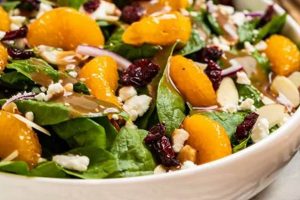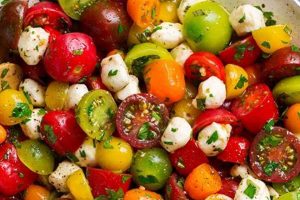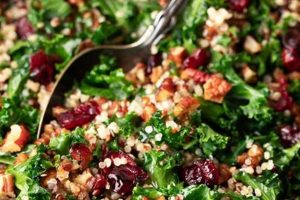A vibrant and customizable dish, this type of salad typically features a mix of crisp vegetables, such as cabbage, carrots, and bell peppers, often combined with protein like grilled chicken or tofu. A flavorful dressing, frequently based on soy sauce, sesame oil, ginger, and rice vinegar, ties the ingredients together. Variations may include additions like mandarin oranges, edamame, crispy wontons, or peanuts for added texture and flavor.
Such salads offer a healthy and refreshing meal option, packed with vitamins, minerals, and fiber. The blend of textures and the savory-sweet flavors make them appealing to a wide range of palates. Adaptable to seasonal ingredients and individual preferences, these salads are a versatile choice for lunch, dinner, or a side dish. Their rising popularity reflects a growing interest in lighter, healthier cuisine with global influences.
Further exploration will cover variations on dressings, ingredient selections, and techniques for achieving the perfect chop, offering readers the knowledge to create their own personalized versions of this delectable salad.
Tips for a Perfect Chopped Salad
Achieving a well-balanced and flavorful salad involves careful consideration of ingredients, preparation techniques, and dressing selection.
Tip 1: Uniformity in Cutting: Consistent bite-sized pieces ensure even flavor distribution and a pleasant textural experience. Aim for pieces roughly the same size, whether dicing, slicing, or shredding.
Tip 2: Ingredient Selection: While classic components provide a foundation, creativity with ingredients can elevate the salad. Consider adding ingredients like shredded red cabbage for color, water chestnuts for crunch, or bean sprouts for freshness.
Tip 3: Balancing Flavors: Harmonizing sweet, sour, salty, and umami elements creates a complex and satisfying flavor profile. Balance the richness of nuts with the acidity of vinegar, or the sweetness of fruit with the saltiness of soy sauce.
Tip 4: Dressing Emulsification: A properly emulsified dressing clings to the ingredients, ensuring every bite is flavorful. Whisk the dressing ingredients vigorously or use a blender to create a smooth, cohesive texture.
Tip 5: Timing of Dressing Application: To prevent the salad from becoming soggy, add the dressing just before serving. This maintains the crispness of the vegetables and prevents the flavors from muddling.
Tip 6: Protein Choices: While grilled chicken or tofu are popular choices, consider other protein sources like shrimp, edamame, or crispy chickpeas. These options add variety and nutritional value.
Tip 7: Garnishing for Visual Appeal: A visually appealing salad enhances the dining experience. Consider garnishes like toasted sesame seeds, chopped cilantro, or crispy wonton strips to add color and texture.
By following these tips, one can consistently create flavorful and satisfying salads, enhancing both nutritional intake and culinary enjoyment.
These guidelines provide a foundation for creating a delicious and personalized salad experience, paving the way for culinary exploration and enjoyment.
1. Fresh, Crisp Vegetables
Fresh, crisp vegetables form the foundation of a successful Asian chopped salad. Their textural and flavor contributions are essential. The crispness provides a refreshing contrast to other ingredients and offers a satisfying bite. Freshness ensures optimal flavor and nutritional value. Examples include Napa cabbage, romaine lettuce, carrots, bell peppers, and cucumbers. These provide varied textures and colors while delivering essential vitamins and minerals.
The choice of vegetables influences the overall culinary experience. Wilted or less-than-fresh produce compromises the salad’s appeal and nutritional content. The crispness of the vegetables also interacts with the dressing. A crisp vegetable maintains its structure and texture when lightly coated with dressing, while a less fresh vegetable may become soggy quickly. This highlights the importance of selecting and preparing fresh vegetables for an optimal culinary outcome.
Selecting and handling fresh vegetables appropriately is paramount. Look for vibrant colors, firm textures, and an absence of bruising or wilting. Proper storage, including refrigeration in airtight containers, maintains crispness and prolongs shelf life. Cutting vegetables into uniform pieces just before assembling the salad further ensures optimal freshness and texture. This attention to detail elevates the final dish, maximizing flavor and enjoyment.
2. Balanced Flavor Profile
A balanced flavor profile is crucial to a successful Asian chopped salad. The interplay of sweet, sour, salty, spicy, and umami elements creates a complex and satisfying culinary experience. This balance prevents any single flavor from dominating, allowing for a more nuanced and enjoyable taste. The foundational savory notes often come from soy sauce or tamari, providing a base upon which other flavors build. Acidity, frequently from rice vinegar or citrus juice, brightens the flavors and adds a refreshing tang. Sweetness, often derived from ingredients like mandarin oranges or a touch of honey, balances the savory and sour components. A hint of spice, perhaps from chili flakes or sriracha, adds complexity and depth. Finally, umami, a savory richness, can be introduced through ingredients like toasted sesame oil, shiitake mushrooms, or fish sauce, enhancing the overall depth of flavor.
Consider a salad with grilled chicken, shredded Napa cabbage, carrots, and mandarin oranges. The savory chicken complements the sweetness of the oranges. The rice vinegar dressing adds acidity, balancing the richness of the sesame oil. A sprinkle of chili flakes provides a touch of heat, further enhancing the complexity of the flavor profile. Without a balanced approach, the salad might taste overly sweet, excessively sour, or simply bland. The intentional layering of these contrasting yet complementary flavors is what elevates the dish from a simple combination of ingredients to a harmonious and satisfying culinary creation.
Achieving this balance requires careful consideration of ingredient selection and proportion. A well-balanced dressing is essential, serving as the unifying element that ties the individual flavors together. Understanding the interplay of these taste elements allows for adjustments based on personal preferences or dietary restrictions. This nuanced approach to flavor ensures a more satisfying and enjoyable dining experience, showcasing the potential of a seemingly simple salad.
3. High-Quality Protein Source
Protein plays a vital role in an Asian chopped salad, contributing not only to nutritional value but also to texture and flavor. The choice of protein significantly influences the overall culinary experience. Selecting a high-quality source enhances satiety and complements the other ingredients.
- Lean Poultry:
Grilled or shredded chicken breast or turkey offers a lean protein source that readily absorbs the flavors of the dressing. It provides a neutral backdrop, allowing the other ingredients to shine while adding a satisfying heartiness to the salad. Chicken, for instance, pairs well with sesame-based dressings and adds a familiar element to the dish.
- Seafood:
Shrimp, scallops, or firm white fish offer a lighter protein option with a delicate flavor. These options bring a subtle sweetness and contribute to a refreshing, less dense salad. Seared or grilled shrimp, for example, complements the bright flavors often found in Asian-inspired dressings.
- Tofu:
Tofu, particularly firm or extra-firm varieties, provides a plant-based protein source that absorbs flavors effectively. Its versatility allows it to complement various flavor profiles. Marinated and pan-fried tofu adds a savory element and a pleasant texture, while maintaining a lighter overall feel compared to meat-based options.
- Legumes:
Chickpeas, edamame, or lentils offer another plant-based alternative, adding both protein and fiber. These options provide a nutty flavor and contribute to a more substantial salad. Roasted chickpeas, for example, provide a satisfying crunch and pair well with the vibrant flavors of Asian cuisine.
The selected protein contributes significantly to the overall balance and enjoyment of an Asian chopped salad. Whether opting for a classic choice like grilled chicken or exploring plant-based alternatives like tofu or legumes, the protein choice influences the nutritional profile, textural complexity, and overall satisfaction derived from the dish. Carefully considering the protein selection in relation to the other ingredients and the chosen dressing ensures a harmonious and well-rounded culinary experience.
4. Crunchy Elements
Crunchy elements play a vital role in the textural complexity of an Asian chopped salad. These elements provide a counterpoint to softer ingredients, creating a more dynamic and enjoyable eating experience. The interplay of textures elevates the salad beyond a simple combination of ingredients, offering a multi-sensory experience. Examples of crunchy elements include toasted nuts (such as peanuts, cashews, or almonds), seeds (like sesame seeds or sunflower seeds), crispy noodles or wontons, and raw vegetables like water chestnuts or bean sprouts. These additions contribute not only textural contrast but also flavor and nutritional value. The absence of such elements can result in a salad that feels one-dimensional and less satisfying.
Consider the contrast between the soft, leafy greens and the crisp, roasted peanuts in a typical Asian chopped salad. The peanuts introduce a satisfying crunch that complements the softer textures of the vegetables. Similarly, crispy wonton strips offer a delicate shatter against the backdrop of tender chicken or tofu. The strategic inclusion of these elements prevents the salad from feeling monotonous, ensuring each bite offers a stimulating textural experience. This textural interplay contributes significantly to the overall enjoyment and perceived quality of the dish. Furthermore, the choice of crunchy elements can also introduce additional flavors and nutritional benefits, such as the healthy fats found in nuts and seeds.
Incorporating crunchy elements demonstrates an attention to detail that elevates the overall culinary experience. This understanding allows for informed choices regarding ingredient selection and preparation. The careful balance of textures within the salad contributes to a more satisfying and memorable meal. By understanding the role and importance of crunchy elements, one can create a more dynamic and enjoyable Asian chopped salad. The thoughtful incorporation of these components ultimately enhances the overall culinary experience.
5. Vibrant Presentation
Vibrant presentation elevates an Asian chopped salad from a simple meal to a visually appealing culinary experience. Color plays a crucial role, stimulating appetite and enhancing perceived freshness. A variety of colorful vegetables, such as deep green spinach, vibrant orange carrots, bright red bell peppers, and purple cabbage, creates an aesthetically pleasing composition. This visual appeal enhances the dining experience, making the salad more enticing and enjoyable. A monochromatic salad, while potentially nutritious, lacks the visual interest that encourages consumption, particularly among children or those seeking a more engaging meal.
Consider a salad composed primarily of iceberg lettuce and pale cucumbers. While these ingredients offer nutritional value, the overall impression is one of blandness. Incorporating elements like shredded red cabbage, orange segments, or a sprinkle of chopped cilantro immediately elevates the visual appeal. This vibrancy signals freshness and a diversity of nutrients. Furthermore, the arrangement of ingredients contributes to the overall presentation. Rather than simply tossing ingredients together, a thoughtful arrangement, perhaps with a central mound of protein surrounded by radiating sections of colorful vegetables, creates a more visually engaging dish. This attention to detail elevates the perceived value and enjoyment of the salad.
Achieving vibrant presentation requires an understanding of color theory and thoughtful ingredient selection. Balancing colors and textures creates a visually harmonious and appealing composition. The practical significance of this understanding lies in its ability to transform a simple salad into a visually stimulating and enjoyable meal. This emphasis on visual appeal not only encourages consumption but also contributes to a more satisfying and memorable dining experience, demonstrating that culinary artistry extends beyond flavor to encompass the visual presentation of a dish.
6. Versatile Dressing
A versatile dressing is essential to a successful Asian chopped salad, acting as a unifying element that binds diverse ingredients and elevates the overall flavor profile. The dressing’s adaptability to various ingredients and flavor combinations distinguishes it. It complements the fresh, crisp vegetables, the chosen protein, and any crunchy elements, enhancing their individual characteristics while creating a cohesive culinary experience. A well-crafted dressing balances sweet, sour, salty, and umami notes, creating a complex flavor profile that complements the other components. This adaptability allows for customization based on individual preferences and dietary needs. For example, a basic vinaigrette can be adapted with the addition of ginger, garlic, or sriracha for added depth and complexity.
Consider a dressing based on soy sauce, rice vinegar, sesame oil, and ginger. This foundational recipe offers versatility. Adding honey or maple syrup introduces sweetness, while chili garlic sauce provides heat. Substituting lime juice for rice vinegar offers a brighter, citrusy note. This adaptability allows the same basic dressing to complement a wide range of ingredient combinations and flavor preferences. A peanut-based dressing, on the other hand, while delicious, may not complement lighter seafood-based salads as effectively as the more adaptable vinaigrette. The versatility of the dressing ensures it can be tailored to specific ingredient combinations, creating a harmonious and balanced final dish.
The practical significance of a versatile dressing lies in its ability to simplify meal preparation while maximizing flavor potential. One foundational dressing can serve as a starting point for countless variations, reducing the need for multiple specialized recipes. This adaptability simplifies meal planning and allows for creative exploration in the kitchen. Understanding the principles of balance and flavor pairing within the dressing allows for informed adjustments and substitutions, empowering individuals to create personalized flavor profiles that cater to specific tastes and dietary requirements. This flexibility underscores the importance of a versatile dressing in the context of an Asian chopped salad, transforming it from a basic dish to a customizable and consistently enjoyable culinary creation.
Frequently Asked Questions
This section addresses common inquiries regarding the preparation and enjoyment of Asian chopped salads.
Question 1: How can sogginess be prevented in an Asian chopped salad?
Sogginess can be prevented by adding the dressing just before serving. Storing the dressing separately from the salad components until serving time helps maintain the crispness of the vegetables. Additionally, ensuring vegetables are thoroughly dried after washing prevents excess moisture from accumulating.
Question 2: What are suitable protein alternatives for vegetarians and vegans?
Tofu, tempeh, edamame, chickpeas, lentils, and nuts offer excellent protein alternatives for vegetarians and vegans. These options provide varying textures and flavors while contributing essential nutrients.
Question 3: Can the salad be prepared in advance?
While the components can be chopped and stored separately in advance, it is recommended to combine them and add the dressing just before serving. This maintains optimal freshness and prevents the salad from becoming soggy.
Question 4: How can sodium content be reduced?
Sodium content can be reduced by using low-sodium soy sauce or tamari. Additionally, incorporating other flavor enhancers like ginger, garlic, and citrus juice can minimize the need for added salt.
Question 5: What are some suitable substitutions for common allergens like nuts and soy?
Sunflower seeds or pumpkin seeds can replace nuts. Coconut aminos or liquid aminos can be used as a soy sauce substitute. Ensure any substitutions align with specific dietary restrictions and preferences.
Question 6: How can leftover salad be best stored?
Leftover salad, without dressing, can be stored in an airtight container in the refrigerator for up to two days. Adding the dressing just before consuming the leftovers helps maintain optimal texture and flavor.
Addressing these common queries provides a deeper understanding of the nuances involved in preparing a successful and enjoyable Asian chopped salad. This knowledge empowers individuals to confidently create personalized variations that cater to specific tastes and dietary requirements.
The following section explores variations on the classic Asian chopped salad theme, providing inspiration for creative culinary exploration.
Conclusion
Exploration of this culinary subject has revealed the multifaceted nature of creating a successful and satisfying dish. Emphasis on fresh, crisp vegetables, a balanced flavor profile incorporating sweet, sour, salty, and umami notes, the strategic inclusion of high-quality protein and crunchy elements, vibrant presentation, and the versatility of the dressing contributes to a holistic culinary experience. Understanding these components allows for informed choices regarding ingredient selection, preparation methods, and flavor combinations, ultimately elevating a seemingly simple salad to a more complex and enjoyable meal.
The adaptability inherent within these salads offers significant potential for personalized culinary expression. Continued exploration of flavor combinations, ingredient variations, and presentation techniques allows for ongoing discovery and enjoyment within the culinary realm. The underlying principles discussed provide a foundational framework for continued experimentation and the creation of personalized versions, ensuring this dish remains a vibrant and evolving culinary staple.






